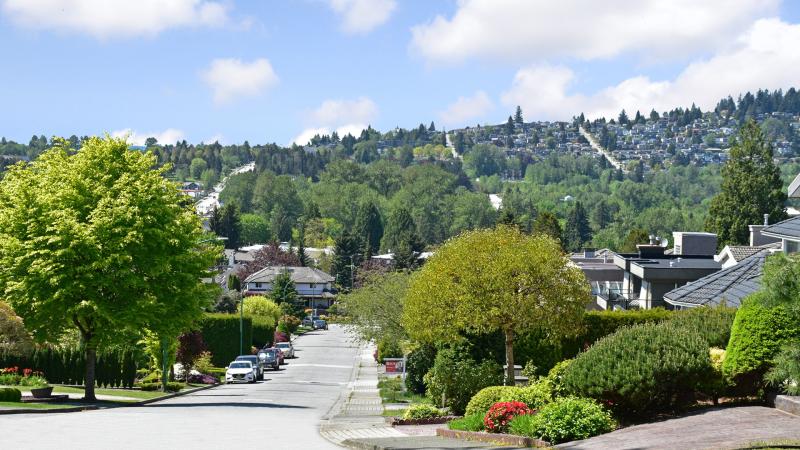

Trees
All about our beautiful trees–how we’re protecting them and what you can do to help
Burnaby Tree Bylaw
Burnaby was once an ancient woodland of hemlock, cedar, Douglas fir and spruce trees. Now it’s home to a variety of urban landscapes with both native and non-native trees. Our tree bylaw protects our trees for future generations while ensuring ample green space for all residents.
Tree replacement
As a condition of your Tree Cutting Permit, you’ll need to replace each tree you remove from your property. The number of replacement trees you need to plant depends on the size of the tree you’re removing.
Tree maintenance
We provide a full range of arboriculture services for City-owned trees–like inspection, pruning and planting.
Our urban forest
Protecting trees is an important priority for Burnaby. Through forward-thinking policies, replanting, and year-round tree care, we nurture an urban forest environment that helps our community and wildlife to thrive.
Trees contribute to our city’s livability. They capture carbon and produce oxygen. They moderate temperature, cooling the city during hot weather and absorbing vast amounts of stormwater which could otherwise lead to flooding. They keep our air clean, fight climate change and provide homes for wildlife.
We’ve developed many initiatives to help protect our urban forest – from increasing foliage on our boulevards to replacing more trees than are removed during construction.
Urban Forest Strategy protects, enhances and expands trees in Burnaby
Faced with challenges such as climate change and population growth, we need to protect our urban forest for future generations. That’s why we’re developing the Urban Forest Strategy to protect, enhance, and expand Burnaby’s trees.
The strategy will be a roadmap for a diverse, resilient and healthy urban forest by protecting, enhancing and expanding tree cover. It will outline a clear, long-term, sustainable approach to managing our urban forest for generations to come.
Learn more about the Urban Forest Strategy.
Is your tree a Protected Tree?
Under the Burnaby Tree Bylaw, a Protected Tree is defined as:
- On properties subject to a development application, any tree 20 cm (8 inches) or greater in diameter.
- On properties NOT subject to a development application:
a. Any conifer tree 30 cm (12 inches) or greater in diameter, and
b. Any deciduous tree 45 cm (18 inches) or greater in diameter. - A Covenanted Tree: is a tree or plant that must be retained or planted per the covenant granted to the City under section 219 of the Land Title Act.
- A tree within a streamside protection and enhancement area as defined in Section 6.23 of the Zoning Bylaw.
- A tree on a lot designated as Cemetery District (P4) under the Zoning Bylaw.
- A tree planted according to a landscaping plan forming part of an approved development application under the Zoning Bylaw or as a condition of subdivision approval.
- A Replacement Tree: tree planted as a replacement for a tree that's been cut, removed or damaged.
- A Retained Tree: an existing tree that has to be retained and protected during construction.
If a tree meets any of these definitions, it is a Protected Tree and you’ll need a tree cutting permit to remove it. You only have to fill one permit application, even if you wish to remove multiple trees.
You don't need a permit to remove trees smaller than 30 cm (12 inches) in diameter unless it's a Protected Tree.
If you're a developer and want to remove multiple trees on City property as part of a project, call 604-297-4500 or email [email protected] for more information.
Questions and answers
All trees play an important part in our city’s natural habitat, and therefore, we protect every tree.
Conifers retain their leaves year-round, have needle or scale-like leaves and bear cones. Douglas fir and western red cedar are examples of conifer trees. Conifers reduce stormwater runoff and filter air pollution because they keep their leaves year-round. They are larger and have a longer lifespan than deciduous trees. They also provide shelter and wildlife habitat.
Deciduous trees shed their leaves each fall and have flat leaves. Maple and oak are both examples of deciduous trees. These trees have broader leaves that provide great shade in the summer and reduce temperatures in urban areas. When the leaves fall in autumn, they decompose and bring a new flush of nutrients into the soil.
As a property owner in Burnaby, you’re responsible for maintaining all the trees on your property.
Under our Tree Management Policy, the City's Forestry Division manages and maintains all the trees on City property, including boulevard trees.
We provide a full range of arboriculture services for City-owned trees, like inspection, pruning, and planting.
Have questions?
| Phone | ||
|---|---|---|
|
Trees on private property |
604-294-7130 |
|
|
Trees on City property / tree service line |
604-297-4500 |
Related links
Local area service program (LASP)
Request changes to your street or lane to improve your neighbourhood.
Burnaby tree bylaw brochure
Detailed questions and answers about Burnaby's Tree Bylaw, including cutting permits, tree replacement, enforcement and LASP.